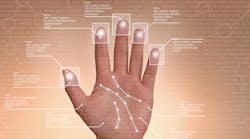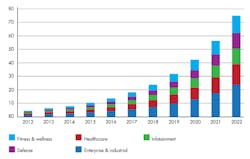Wearable technology is a strong trend in the Internet of Things community. The new Apple Watch now has the potential to perform electrocardiograms, introducing FDA-approved devices to the mass consumer market. Wearable technology use will only increase as developers and engineers create smaller and more efficient devices.
To that end, Purdue University has developed new wearable technology that can be applied like a sticker—allowing for ease-of-use and flexibility while monitoring physical activity and alerting the wearer about possible health risks.
Trends in Wearable Technology
According to Grand View Research, the wearable market will become a $70-billion industry by 2022. The leading markets will be fitness/wellness, healthcare, and infotainment. The increase in smartphone use and internet mobility will drive the creation and adoption of wearable technology.
North America wearable technology market by application, 2012-2022 (USD Billion) (Image credit: Grand View Research)
The main use of these devices is to monitor activity. According to the research firm Quantzig, manufacturing companies will procure devices for their workers, with the aim of monitoring their physical exertion and ensuring their safety. Military branches and security services have also increased their use of wearables technology. The uses range from smart watches and glasses to smart helmets, technology-embedded clothing, and GPS tracking capabilities.
Healthcare is one of the biggest sectors that will be impacted by wearable technology. These are the four main uses of wearable tech within healthcare according to Quantzig:
- Preventative healthcare. Increased awareness surrounding fitness and well-being is fueling the purchases of wearable devices. It helps individuals keep track of daily fitness activities without having to see a physician. Wearable devices can monitor heart rate and calories lost and help promote a healthier lifestyle.
- Faster As the use of wearable devices increase, so does the volume of data collected. Doctors will soon be able to make use of the analytics collected by wearables both to improve treatments at the micro level and help determine trends at the macro-societal-level. Stanford Medicine enrolled more than 400,000 people for its Apple Heart Study in 2017.
- Reduced prescription fraud. By using wearable devices, medical institutions will be able to determine if a patient is misusing or reselling their drugs. Tracking their activities and using the analytical data collected from wearable technology, medical institutions can use predictive analytics to detect exceptions and irregular patterns not in line with their treatment. Once these patterns are identified, they can take preventive measures to stop abusive drug behavior.
- Real-time patient monitoring. Probably the largest benefit is that of real-time monitoring of patients. Doctors can be notified of any sudden and dangerous fluctuations in a patient’s First responders can be notified of a patient’s location instantly, hospitals can be notified in advance of incoming hospitalization requirements, and doctors can be called prior to patient arrival. For example, the Apple Watch Series 4 can now detect when the wearer falls or has an irregular heartbeat. For either instance, emergency responders can be notified and summoned to the wearer’s location.
Purdue’s Smart Sticker Wearables
Purdue University researchers have created wearable electronic devices that can easily attach to the skin. The devices are made from paper to lower the cost of personalized medicine. (Image credit: Purdue University)
In an effort to make wearable technology smaller and easier to wear, researchers at Purdue University have created wearable stickers out of paper towels. Recently published in ACS Advanced Materials and Interfaces, the technology can be easily applied to the skin and adhere with just water. These “smart stickers” are made of cellulose, which is both biocompatible and breathable. They can be used to monitor physical activity and alert a wearer about possible health risks in real time.
“For the first time, we have created wearable electronic devices that someone can easily attach to their skin and are made of paper to lower the cost of personalized medicine,” said Ramses Martinez, a Purdue assistant professor of industrial engineering and biomedical engineering who led the research team.
The stickers can be used as implantable sensors to also monitor a patient’s sleep because they conform to one’s internal organs without causing any adverse reactions. The stickers can be applied to athletes to monitor their health while exercising, playing sports, or even swimming.
The stickers are patterned in serpentine shapes to make the devices as thin and stretchable as possible, thus making them almost imperceptible to the wearer. The stickers are coated with molecules that repel water, oil, dust, and bacteria. This ensures the stickers last longer than typical paper. The stickers only cost a nickel to produce and can be made using the same printing technology used to print books at high speeds.
According to Martinez, “The low cost of these wearable devices and their compatibility with large-scale manufacturing techniques will enable the quick adoption of these new fully disposable, wearable sensors in a variety of healthcare applications requiring single-use diagnostic systems.”
The technology is patented through the Purdue Office of Technology Commercialization. The researchers are continuing to look for partners to test and commercialize the technology.



